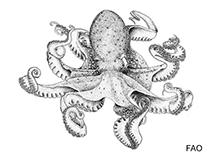Praealtus paralbida Allcock, Collins, Piatkowski & Vecchione, 2004
White octopusGoogle image | No image available for this species;
drawing shows typical species in Octopodidae.
Classification / Names Populärnamn | synonymer | CoL | ITIS | WoRMS
Cephalopoda | Octopoda | Octopodidae
Environment: milieu / climate zone / djupintervall / distribution range Ekologi
. Temperate
Distribution Länder | FAO områden | Ekosystem | Förekomster | Utplanteringar
Atlantic Antarctic:: Southern Ocean.
Length at first maturity / Size / Weight / Age
Könsmognad: Lm ? range ? - ? cm
Life cycle and mating behavior Könsmognad | Reproduktion | Lek | Eggs | Fecundity | Larvae
Main reference
referenser | Koordinator | Medarbetare
Allcock, A.L., M.A. Collins, U. Piatkowski and M. Vecchione 2004 Thaumeledone and other deep water octopodids from the Southern Ocean. Deep-Sea Research Part II Topical Studies in Oceanography 51(14-16) 2004:1883-1901. (Ref. 84298)
IUCN Red List Status
(Ref. 130435: Version 2025-1)
CITES status (Ref. 108899)
CMS (Ref. 116361)
Threat to humans
Human uses
| FishSource |
Verktyg
Ytterligare information
Födosammansättning
Födointag
Predatorer
Max. ages / sizes
Length-weight rel.
Length-length rel.
Length-frequencies
Mass conversion
Abundans
FAO områden
Ekosystem
Förekomster
Utplanteringar
Internet-källor
BHL | BOLD Systems | CISTI | DiscoverLife | FAO(Publication : search) | Fishipedia | GenBank (genome, nucleotide) | GloBI | Gomexsi | Google Books | Google Scholar | Google | PubMed | Tree of Life | Wikipedia (Go, sök) | Zoological Record



